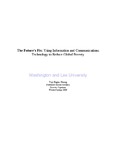| dc.rights.license | In Copyright | en_US |
| dc.creator | Huang, Yuji E. | |
| dc.date.accessioned | 2013-12-03T13:54:53Z | |
| dc.date.available | 2013-12-03T13:54:53Z | |
| dc.date.created | 2009 | |
| dc.identifier | WLURG38_Huang_POV_2009_wm | |
| dc.identifier.uri | http://hdl.handle.net/11021/24185 | |
| dc.description | Yuji E. Huang is a member of the Class of 2009 of Washington and Lee University. | en_US |
| dc.description | Capstone; [FULL-TEXT FREELY AVAILABLE ONLINE] | en_US |
| dc.description.abstract | Technological inventions such as the Internet, satellites, mobile technology, and wireless access to information have infiltrated nearly every aspect of human life: personal communication has become distant and instant, businesses have used the speed and interconnectivity of new technology to great advance, and "Google” has become a verb. While modern technology has undoubtedly revolutionized life in the developed world, the impact of modern technology on the developing world is perhaps more complex. On one hand, governments in developing nations, private non-governmental organizations (NGOs), and groups such as the United Nations or the World Bank have heralded the so-called "information and communications technologies for development (ICT4D)” movement; these proponents see in this approach the potential for a poverty panacea. Critics of the information and communications technologies (ICT) efforts, however, speculate that such a plan would only further exacerbate impoverished conditions in the developing world by causing these nations to be increasingly marginalized. Such critics believe that the continued use of ICTs to encourage development can actually have the reverse effect of increasing the "digital divide” between the rich and the poor, the urban and the rural, the developed and the significantly less so.
This paper addresses several questions regarding the use of ICTs and the ICT4D movement at large. First, how did the movement come to originate, and who are the major players? Second, what are the theoretical arguments for the ICT4D movement, and how does the theory translate into practice? Third, what are the arguments against the movement, and what evidence of failure in prior case studies exists to support these arguments? Finally, what, if any, benefits can reasonably be expected from continuing the ICT4D movement, and how can individuals and institutions best ensure the most beneficial, or the least harmful, application of ICT4D strategies? | en_US |
| dc.description.statementofresponsibility | Yuji Eugina Huang | |
| dc.format.extent | 23 pages | en_US |
| dc.language.iso | en_US | en_US |
| dc.rights | This material is made available for use in research, teaching, and private study, pursuant to U.S. Copyright law. The user assumes full responsibility for any use of the materials, including but not limited to, infringement of copyright and publication rights of reproduced materials. Any materials used should be fully credited with the source. | en_US |
| dc.rights.uri | http://rightsstatements.org/vocab/InC/1.0/ | en_US |
| dc.subject.other | Washington and Lee University -- Capstone in Shepherd Program for the Interdisciplinary Study of Poverty and Human Capability | en_US |
| dc.title | The Future's Fix: Using Information and Communications Technology to Reduce Global Poverty | en_US |
| dc.type | Text | en_US |
| dcterms.isPartOf | RG38 - Student Papers | |
| dc.rights.holder | Huang, Yuji E. | |
| dc.subject.fast | Capabilities approach (Social sciences) | en_US |
| dc.subject.fast | Poverty | en_US |
| dc.subject.fast | Millennium Development Goals | en_US |
| dc.subject.fast | Globalization | en_US |
| dc.subject.fast | Developing countries | en_US |
| dc.subject.fast | Communication -- Technological innovations -- Social aspects | en_US |
| local.department | Shepherd Poverty Program | en_US |
| local.scholarshiptype | Capstone | en_US |
